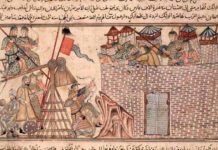Dr. José Protasio Rizal Mercado y Alonso Realonda (June 19, 1861 – December 30, 1896) was a Filipino novelist, poet and medical doctor. His writings angered the Spanish authorities and Rizal was executed by firing squad.
Jose Rizal Biography: Becoming a Filipino Revolutionist
Rizal was born on June 19, 1861, in Laguna of parents who belonged to the local elite. After attending the Ateneo Municipal de Manila, he enrolled in Medicine and Philosophy and Letters at the University of Santo Tomas and then went to Madrid, Spain, to continue his studies at the Universidad Central de Madrid, specializing in ophthalmic surgery. After obtaining his degree, he served as an assistant under two eminent European ophthalmic surgeons, Louis de Wecker in Paris, France and Otto Decker in Heidelberg, Germany.
Noli Me Tangere
While studying in Spain, Rizal got involved with Filipino students who agitated for Philippine reforms. In Berlin, he wrote his first novel, Noli Me Tangere, which means don’t touch me, the first socio-political novel exposing the evils and despotism of the colonial government and the Spanish clergy and Filipino life in the Philippines. Rizal wrote books and poems to express his sentiments and secure political and social reforms. Rizal’s writings drew strong attacks from the Spanish authorities. The Spanish clergy charged that “ the work Noli Me Tangere has been found heretical, impious and scandalous from the religious perspective, anti-patriotic and subversive from the political point of view, injurious to the Spanish government…”
Catalyst for the Revolution
Rizal returned to the Philippines in 1892, and formed a non-violent organization called La Liga Filipina, or the Philippine League, despite warning from his friends and family as he was wanted by the authorities. Rizal was soon arrested and deported to Dapitan in Zamboanga. During his four years of exile, Rizal founded a school and hospital, installed a street lighting system, built a drainage system, introduced fishing methods, wrote poems and carved sculpture.
My Last Farewell
Before the night of his execution, Rizal wrote the last poem, Mi Ultimo Adios (My Last Farewell). The first paragraph starts:
Farewell, dear Fatherland, clime of the sun caress’d
Pearl of the Orient seas, our Eden lost!,
Gladly now I go to give thee this faded life’s best,
And were it brighter, fresher, or more blest
Still would I give it thee, nor count the cost.
This is the best-loved Filipino poem and every Filipino person knows at least the first line of the poem.
At 35, Rizal was publicly executed in Bagumbayan, Manila (now called Rizal Park) and became a victim of Spanish colonialism and martyr of the Philippine Revolution.
Most Important Historical Figure of the Philippines
In the Philippines, the Rizal presence is everywhere. There are Rizal monuments, statues and plazas all over the country. His face appears on the two-peso bill, the one peso coin and postage stamps. Every main street in the Philippines is named after him, as well as an entire province, a university, a park, a theatre, schools, buildings and even mundane products such as cement, beer, matches and cigars. Anniversary of his birthday, June 19 and his martyrdom, December 30 are both national holidays. Many films and plays about him have been produced.
Sources:
- King, J, Great and Famous Filipinos, Worldlink Books, Manila, 2001
- Roces, A, Culture Shock Philippines, Marshall Cavendish, New York, 2009








